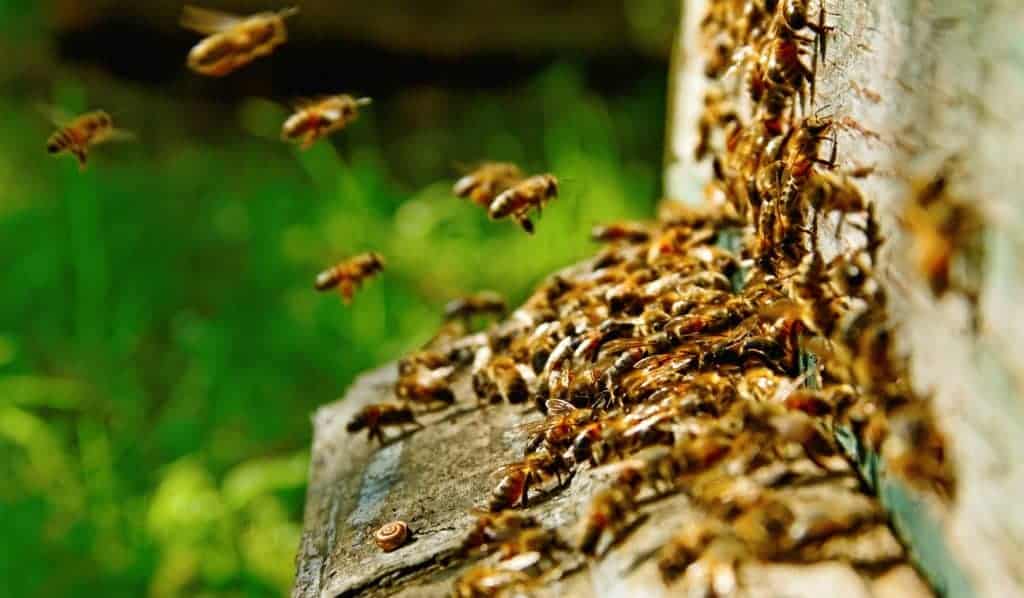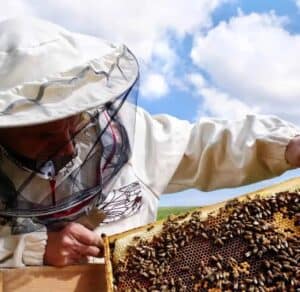When Is The Best Time Of Day To Inspect a Beehive? Grumpy Bees?
As I explore the many aspects of beekeeping, I wanted to know the ideal time to inspect my hives. Like most beekeepers, I’d rather deal with happy bees and reduce the number of stings I receive.
When is the best time of day to inspect a beehive? The best time to inspect your hives is on calm, warm and sunny day between 11am and 4pm. The forager bees will be out working rather than guarding the hive. Flying bees are happy bees.
Inspecting your hives is one of the most important aspects of beekeeping. I spent some time researching and speaking with experienced beekeepers to learn the best time to inspect your bees and why. I received a wide variety of answers which I will explain in more detail.
When Should I Inspect My Beehive

Inspecting your hives is the most fun, exciting and informative part of beekeeping. It is recommended to inspect your hives at least every 7 to 10 days for beginners. Most experienced beekeepers recommend at least once per week.
It’s ideal to inspect your hives on calm (low winds), warm and sunny days around 11am to 4pm. This will ensure less bees in the hive since the forager bees will be out working and not guarding. The colony is concentrating on working rather than guarding the hive from you.
Some beekeepers will follow 2 simple rules:
- If the grass is still wet with dew from the night before, its too early to inspect your colonies.
- If the sun has just fallen below the horizon, its too late to inspect your hives.
Practically speaking, inspecting your hives on a sunny day makes it far easier for you to spot the eggs, brood, and to find the queen. Try to keep your inspection time to a minimum, 30 mins to 1 hour is recommended, but you’ll become quicker with experience.
It’s not a good idea to work bees at night, or during stormy, windy or cold weather. This will make your inspection quite miserable because you’ll be dealing with very grumpy bees.
Unfortunately, inspecting your hives at the perfect time of day with the perfect weather is not always possible. This is especially true for commercial operations with a lot of colonies to manage.
A common saying amongst commercial beekeepers is: “Do things when you can, not when you want to”.
Beekeepers love to tell war stories about receiving 10-15 stings when inspecting hives full of grumpy bees. But, if you work bees and get the crap stung out of you and keep going no matter what, then you are a beekeeper.
What To Look For When Inspecting Hives

It is important to be thorough when inspecting your hive. Make use of smoke to calm the bees, but not too much, before opening the hive and inspecting all frames. It is recommended to look for the following:
- Find the queen – is she present and laying? It’s good to find the queen every time you inspect the hive but not required if you observe evidence of new eggs and brood.
- Check for queen cells
- Check for eggs – they look like grains of rice and they’re should only be one per cell in the middle. If there is more than one per cell, then you have laying workers and you will need to address this. The bottom center of the frame is usually the best place to locate eggs.
- Check for larvae – part of your inspections is to look for brood, which is capped and uncapped larvae.
- Check for parasites – mites, wax moth larvae and foulbrood.
- Room for expansion – ensure your colony has enough room – you don’t want your bees to swarm.
- Enough stores – ensure your colony have enough stores of pollen and honey.
Don’t forget to bring the right equipment for working bees. You’ll need the following:
- Hive Tool
- Smoker
- Bee suit and Veil
- Extra Frames
By taking the time to inspect your colonies on a weekly basis, you’ll ensure the health and growth of your colonies. This is also the most informative and fun part of beekeeping, working with your bees.
How To Spot The Queen

This can be difficult when new to beekeeping and will become easier with practice. If you purchased your queen, she’ll likely come marked already and be easier to spot. If not marked it will take you a little more time to find her.
The queen has a long slender unstriped abdomen and usually a circle of worker bees around her. It is easier to scan the frames in a circular motion working from the outside in covering the entire frame slowly and methodically.
Pro Tip: Use minimal smoke or you’ll scare the queen away and she’ll be difficult to find.
The best place to start is on a frame of brood with the most bees. Ninety percent of the time you’ll find the queen they’re first. The queen is a different color than the other bees, but this doesn’t help much since she still blends in very well.
The queen moves differently, more slowly and gracefully compared to the rest of the bees. Spending time observing the queen and the bees around, you’ll notice that the worker bees around her also act differently.
If you believe your hive is queenless, be sure to inspect your colonies early in the day or late evening for a virgin. She could be out during the day on mating flights.
Having marked queens is more convenient as a new beekeeper. However, having the ability to find unmarked queen bees is a skill you’ll need as you become a successful beekeeper.
Oh No! Is My Beehive Queenless

It’s important to identify if your colony is queenless early on. The longer your colony has no queen the harder it’ll be to recover. Here are the most common indicators of a queenless hive:
Lack of Brood & Eggs – the queen is the only bee that can lay fertilized worker bee eggs. This will be the first thing missing in a queenless colony. You will also notice less larvae or capped brood.
Extra Honey & Pollen – since there is less eggs for the worker bees to care for, this creates an imbalance within the colony. The bees will likely increase foraging and storing food. You will observe an increase in honey and pollen store but no brood.
Queen Cells (cups) – as this is not unusual to see in a healthy colony, if you see these in combination with no brood its likely queenless.
Unhappy Bees – bees with no queen are very grumpy, restless and easily angered. They’ll often make a high-pitched whine and/or low roar when opening the hive. You’ll also observe a drop in population.
Multiple Eggs – if you observe multiple eggs per cell then you porbably have worker bees laying unfertilized eggs. This is a very difficult situation to recover from since the worker bees will likely kill a newly introduced queen to the colony.
It’s best to consult an experienced beekeeper to assist in trying to recover this colony. Some would consider this a complete loss and make no attempt at recovery.
Depending on how many of the above factors you observe, and how quickly you can respond, will determine the difficulty of recovering your colony. The two main recovery methods are:
- To install an adult queen or
- Allow the bees to make their own queen from young brood you install from a queenright colony.
Related Questions
What is the best direction to face a beehive? Bees do not care what direction their hive is facing. Bees in the wild have not demonstrated a statistical preference when choosing one direction for the front of their hives. Bees are flexible and will adjust to their environment.
What is the best wood for a beehive? The best wood for beehives is a good select grade premium pine. Pine lumber is easy to work with, it’s available everywhere in North America & Europe, and it’s the most affordable. Your pine bee boxes will last decades if properly treated and looked after.
What is the best paint for beehives? The best paint for beehives is a water-based latex paint, rated for exterior use with low levels of VOC’s (volatile organic compounds). The VOC’s should be under 100 but ideally you want 50 or lower. This will protect your beehive against the elements while ensuring the safety of your bees.

Joseph Davis
My goal is to show that anyone can take up beekeeping and it can be a very rewarding hobby. I strive to share my experiences and answer any questions you may have.
